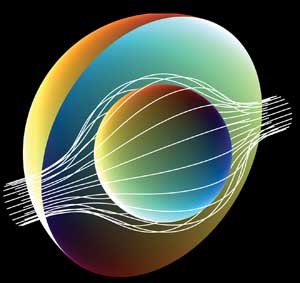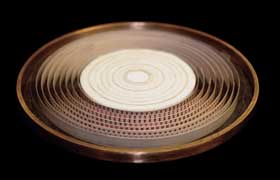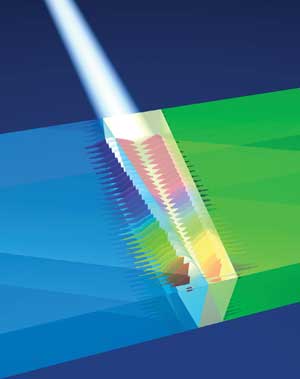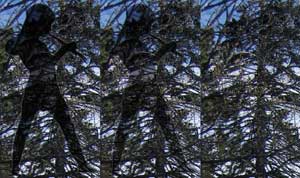
Metamaterials: Photonic Sleight of Hand
Invisibility cloaks, perfect imaging, enhanced photovoltaic light collection, all-optical memories and biosensing are just some of the intriguing applications of metamaterials currently grabbing headlines in scientific journals.
The field of metamaterials is barely 10 years old. First conceived in 2000 by Sir John Pendry at Imperial College London, metamaterials relied in the early days on advances in nanotechnology to build tiny structures such as metallic rings or wires smaller than the wavelength of light. These nanostructures modify the electromagnetic properties of the metamaterial, sometimes creating seemingly impossible optical effects.
Much success has already been demonstrated at microwave frequencies: metamaterial antennas, transmission lines and resonators, which have been harnessed for wireless technology applications. These have led to commercially available products such as routers by Netgear, cell phones by LG Mobile and wireless electricity by WiTricity.
But the situation is radically different in the optical regime, where the visionary applications such as enhanced photovoltaic light collection, biosensing, perfect imaging, all-optical memories and, of course, invisibility cloaks are expected to have the highest and most wide-ranging impact.

Rays enter the cloak through the outer surface and are guided around the hidden region. The figure shows trajectories of rays through the cloak, which avoid the cloaked region and return to their original path after traversing the cloak. The observer is not aware of either the cloak or the hidden object. Courtesy of John Pendry, Imperial College London.
Although the basic building blocks and enabled functionalities of these extraordinary media have (at optical wavelengths) been created and experimentally demonstrated, bringing optical metamaterials out of the laboratory remains a tall order, said professor Ortwin Hess, the Leverhulme Chair in Metamaterials at Imperial College London.
“All present-day optical metamaterials are extremely thin and at visible wavelengths only very lossy, while entailing expensive top-down synthesis techniques that inhibit the judicious/accurate construction of their nanometer-scale (metallic) meta-atoms, rendering their reproducibility over macroscopic dimensions or their integration into three-dimensional devices very challenging,” Hess said.

A 3-D metamaterial schematically indicates coupled metamolecules in the form of split-ring resonators. Courtesy of Ortwin Hess.
Invisibility cloaks
The object causing the most fascination in both technical and general journals is the invisibility cloak, which works by bending light around itself to effectively make an object “disappear.”
But perfect invisibility is impossible, according to Ulf Leonhardt, a professor at the University of St Andrews in Scotland. The trouble is, metamaterials for visible light are plagued by losses, and the solution calls for either another material or a better design idea.
“Metamaterials are normally made of metals,” Leonhardt said. “Metals are nearly perfect conductors for electromagnetic microwaves but are much less perfect for visible light.”
For true optical invisibility, the constituent elements of the metamaterial must be significantly smaller than the wavelength, losses must be minimized or compensated (otherwise the cloak would appear as a dark silhouette) and, finally, the material must work over a broad frequency range and possibly be flexible.

Pictured is professor Ulf Leonhardt’s vision forperfect imaging of microwaves. Using a two-dimensional version of the fish-eye lens, the perfect lens uses a metamaterial constructed from concentric bands of copper circuit board surrounded by a metallic mirror. Courtesy of Yungui Ma.
The importance of metamaterial cloaking, however, is not limited to optical invisibility; reduced optical as well as acoustic visibility and, more generally, appearance are just as important, Hess said.
“Photonic examples might be the reduction of the signature of an object to radar, the illusion of a smaller or bigger shape, or even an increase of the absorption of a material such that none of the radiation is reflected (of high importance for applications such as solar cells),” he said. “If we think about acoustic cloaking, we might envision the shielding of an environment to incoming or outgoing noise, allowing, for example, the conception of directed noise emanating from sources such as an airplane engine to be directed away from the ground.”
Optical memory
But there are many other exciting applications of metamaterials in the realms of imaging, field localization or slow light and, in particular, stopped light, which appears to be possible only with materials with negative parameters: susceptibility, permeability and refractive index.
The ability to stop and store optical pulses could usher in a range of fundamentally new and revolutionary applications such as all-optical memories. But scientists have encountered some formidable challenges.
“This highly unusual state for an electromagnetic wave refers to the situation where the lightwave completely stops despite the absence of any dielectric or other barriers in the directions where it could propagate,” Hess said. “Unlike the confinement inside a dielectric cavity, where one cannot spatially separate optical bits of information, a stopped-light structure would allow for sequentially stopping and storing spatially separated optical bits, thereby potentially leading to all-optical memories.”
But there’s a catch. Stopping light cannot be achieved with nonswitchable periodic structures such as photonic crystals or coupled-resonator optical waveguides because of their extreme sensitivity to disorder, which invariably destroys the zero-group-velocity (ZGV) point(s).
“With atomic electromagnetically induced transparency, one coherently imprints the shape of an optical pulse into, for example, an electronic spin excitation; i.e., light is ‘stored’ but not stopped because at the ZGV point, all photons are converted into atomic spin coherence,” Hess said.
In a groundbreaking paper published in Nature in 2007, Hess and colleagues presented their “trapped rainbow” idea for true stopping of light in solid-state structures and at ambient conditions (room temperature). Instead of relying on periodic backreflections or on resonances, the deceleration of light in this method is based on the use of negative effective electromagnetic parameters in metamaterial waveguides that cause negative Goos-Haenchen phase-shift steps (i.e., deceleration) in the propagation of a light ray.

The trapped rainbow concept uses negative phase shifts in metamaterial heterostructures to decelerate a light beam and separate its colors. Courtesy of Ortwin Hess.
Project ACEPLAN, a collaboration between Imperial College London and Tampere University of Technology in Finland, is investigating the possibility of using surface plasmons to create low-loss plasmonic components.
One of the project’s aims is to alleviate or even remove the unavoidable absorption losses caused by a metal by amplifying the plasmon waves with semiconductor quantum wells and dots. Using this approach, Hess hopes to design and fabricate novel wide-band, low-loss or even lossless metamaterials – highly promising structures for slowing or even stopping incoming light pulses.
“Perfect” lenses, light harvesting, semiconductors
For Leonhardt, the most promising potential for metamaterials is based on transformation optics for imaging with a resolution that is no longer limited by the wave nature of light.
The “perfect lens” idea was first conceived by Pendry in 2000 when he introduced the concept of metamaterials. The lens he proposed could bend light in extraordinary ways so as to effectively beat the diffraction limit.

If painted entirely black, the Peter Pan statue in London’s Kensington Gardens would not be invisible. Against a bright background, a black figure is perfectly visible. Courtesy of John Pendry, Imperial College London.
Then in 2009, Leonhardt postulated that using transformation optics, a fish-eye lens should in fact image waves with perfect resolution. The fish-eye lens acts as a virtual sphere. It directs light around the virtual sphere of the lens to a point on the opposite side of the sphere. This means that any light emitted from any direction traces arc shapes to a meeting on the opposite side.
The theory, however, is greatly debated, with many scientists including Pendry voicing doubt over its validity. But Leonhardt remains unfazed because experiment has shown that it works, he says.
“As with Pendry’s prediction of perfect imaging, this proposal created much controversy, in part because it sounds too good to be true and in part because it contradicts accepted wisdom,” Leonhardt said. “However, we have recently demonstrated perfect imaging for microwaves in an experiment using a two-dimensional version of the fish-eye lens.” Leonhardt also believes that a prototype for infrared light can be built within a year.

The hard part of invisibility is eliminating the shadow. Here Photoshop has been used to remove successively 25 percent, 50 percent and all of the shadow. Many objects are detected primarily through their shadows. An example would be the black ball used in a game of squash. Courtesy of John Pendry, Imperial College London.
Imagine being able to gather light from a wide area and compress the energy into a very small volume. The possibility could revolutionize photovoltaic systems as well as make for very sensitive detectors of biologically active molecules, sensitive to perhaps even a single molecule.
Pendry is working on this concept and predicts that the optical applications of superfocusing could be a reality in around five years.
For Hess, the focus is to develop active metamaterials that are fully compatible for large-scale semiconductor integration. This includes the modeling, experimental realization and optical characterization of all-semiconductor-based metamaterials.
Suitable loss-compensated semiconductor-based metamaterials are expected to be realized within the next two years.
To further this research, Hess intends to explore the quantum aspects of semiconductor-based metamaterials, which could lead to the development of ultrafast nanolasers. Such sources can be realized only with better understanding of how quantum control can be exerted on nanoscale plasmonic and semiconductor metamaterials.
While Hess concedes that metamaterial quantum technologies are not expected in our immediate future (10 to 15 years), he maintains that it is important for work to begin now.
Published: September 2011